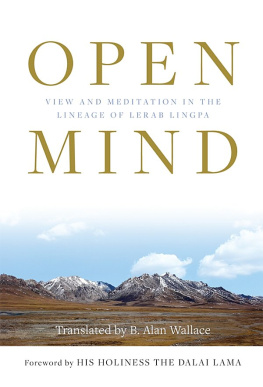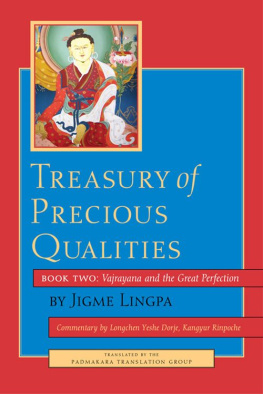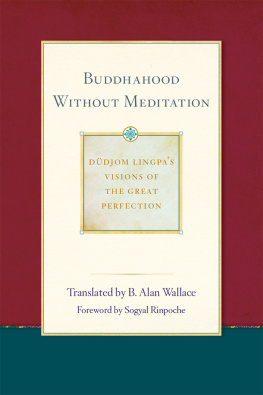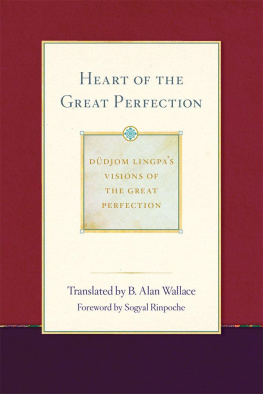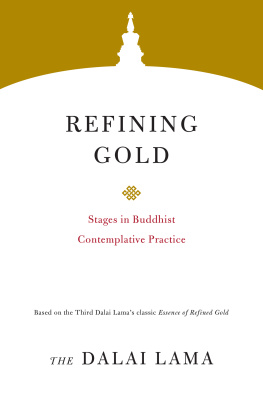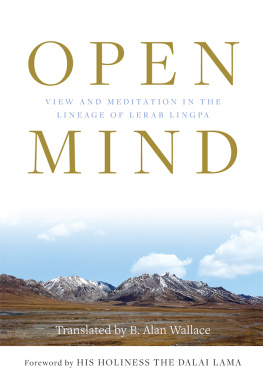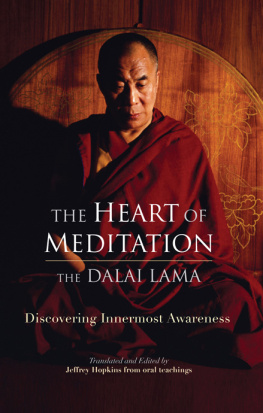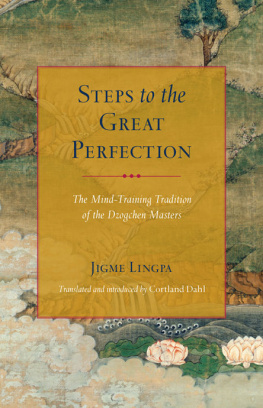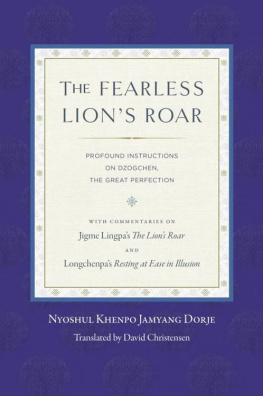
Study the Great Perfection with the celebrated Lerab Lingpa, and discover the common ground of Tibetan Buddhisms many schools in essays by his disciples.
L ERAB L INGPA (18561926), also known as Tertn Sogyal, was one of the highly influential Dzokchen (Great Perfection) masters of the nineteenth and early twentieth cen-turies. This volume contains translations by B. Alan Wallace of several representative works from the lineage of this magnificent treasure revealer, or tertn.
Composed by Lerab Lingpa, The Vital Essence of Primordial Consciousness presents instructions on all the stages of the Great Perfection, which is the highest form of meditation and practice in the Nyingma school of Tibetan Buddhism.
The Selected Essays on Old and New Views of the Secret Mantrayana is a collection of seven essays by two of Lerab Lingpas close disciples, Dharmasra (a.k.a. Lozang Do-ngak Chkyi Gyatso) and J Tsultrim Zangpo (a.k.a. Tulku Tsullo). Dharmasras six essays provide detailed explanations of the compatibility among the theories and practices of the Great Perfection, Mahmudr, and the Madhyamaka view. J Tsultrim Zangpos essay, a special favorite of the Dalai Lama, contextualizes the Great Perfection within the broader framework of Mahyna and Vajrayna Buddhism and then elucidates all the stages of practice of the Great Perfection.
Open Mind will be welcomed by all those interested in the theory and practice of the Great Perfection and the way it relates to the wisdom teachings of Tsongkhapa and others in the new translation schools of Tibetan Buddhism.
Lerab Lingpa, J Tsultrim Zangpo, and Lozang Do-ngak Chkyi Gyatso all have the unusual ability to teach the profound wisdom of the Great Perfection out of their own experience in a direct and meaningful way to Dharma students living in our challenging times. Its a tribute to Alan Wallace, a long-term practitioner, Dharma teacher, and scholar, that he has translated these teachings (a very difficult task) into clear and sparkling prose that we can understand and use for practice.
TSOKNYI RINPOCHE, founder, Pundarika Foundation and author of Open Heart, Open Mind

FOREWORD BY
HIS HOLINESS THE DALAI LAMA
Buddhism was established in Tibet by the great Dharma king Trisong Detsen, the abbot ntarakita, and the adept Padmasambhava more than 1,200 years ago. The ordination of monks, monastic discipline, methods for developing concentration, as well as the study of philosophy under the rubric of strict logic and epistemology make up the general structure of the teachings. Guru Padmasambhava also introduced his disciples to more specialized instructions that included the practice of tantra and the teachings on the Great Perfection.
In the Nyingma tradition a succession of nine vehicles is explained: the vehicles of rvakas, pratyekabuddhas and bodhisattvas; the three outer tantras of kriya, upa, and yoga tantra; and the three inner tantras of mahyoga, anuyoga, and atiyoga. The first eight of these vehicles take the ordinary mind as the path. Atiyoga, which corresponds to the Great Perfection, takes primordial consciousness as the path.
When we speak of taking primordial consciousness as the path, we are referring to our fundamental nature, the unchanging awareness that is never tainted by the fleeting stains of discursive thought. Neither the phenomena of sasra nor their causes, the karmic winds and ordinary thought patterns, have ever clouded the purity of this awareness.
The coarse level of our ordinary consciousness does not continue until buddhahood, as only the fundamental innate mind of clear light can be present in the state of omniscience. This fundamental innate mind of clear light is the primordial consciousness spoken of in the Great Perfection. It is the primordial consciousness that the Great Perfection takes as the path. The highest yoga tantras of the new translation tradition follow the same principle, using techniques reliant on the ordinary coarse mind in order to manifest the fundamental innate mind of clear light, while the Great Perfection employs nothing but the fundamental innate mind of clear light.
Taking the primordial consciousness of pristine awareness as the path is a process of revealing our subtlest level of awareness and enabling it to find its own stability by working with and experiencing the aware aspect of the fundamental innate mind of clear light. This is the extraordinary, profound, and unique feature of the Great Perfection.
Padmasambhava concealed countless spiritual treasures, or terma, destined to be discovered at opportune times by successive incarnations of his chief disciples. Lerab Lingpa, author of the first text in this book, was a tertn, a revealer of such treasures, who gave important transmissions to my predecessor, the Thirteenth Dalai Lama.
The first part of this book, a translation of The Vital Essence of Primordial Consciousness, consists of Lerab Lingpas instructions derived from treasures he had revealed on how to practice and uncover our most subtle level of awareness.
The second part of the book consists of essays by more recent scholar-adepts on the place of specialized instructions such as the Great Perfection in the context of the general structure of Buddhas teachings. Their conclusions support the observation of the seventeenth-century master Panchen Losang Chkyi Gyaltsen, who wrote that when the numerous traditions are scrutinized by a yogi learned in scripture, logic, and meditative experience, their definitive meanings all converge on the same intended point.
I value the care with which B. Alan Wallace has translated these works into English, making them available to a wider interested readership. I have known Alan for many years and appreciate his work as a translator, as well as his exploration of the qualities of the mind, first as a monk and later as a scientist and a contemplative.
All levels of consciousness including the coarsest level of our ordinary minds are permeated by an aspect of the subtlest awareness, or clear light. This can be pointed out to us by an experienced master in whom we have faith. When we recognize the nature of this subtlest awareness, we can take it and it alone as the basis of our practice. May this book inspire readers to develop such an understanding of the nature of the mind and to then experience it in actual practice.
Tenzin Gyatso, the Fourteenth Dalai Lama
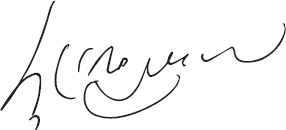
PREFACE
The Tibetan voices we hear in this volume often seem to be speaking to us directly, here and now. Though their worlds would in many ways appear to be quite foreign to us, these authors are grappling with questions of worldview and practice that are no less pressing today, even among practitioners living in modern cultures far removed from theirs. These masters frequently address crucial differences in presentation that exist across the great lineages of Tibetan Buddhism. They also offer glimpses of how to understand a deeper compatibility between those presentations in ways that are rarely explained, even among millions of pages of Tibetan literature.
The three authors whose works are translated here lived during a pivotal period of Tibetan history, from the second half of the nineteenth century through the first half of the twentieth. It was a time when the conditions were ripe for unprecedented dialogue between master scholars trained in multiple traditions, who often combined extensive knowledge of Geluk, Sakya, and Kagy perspectives with authentic experience of the Great Perfection (Tibetan: Dzokchen) tradition associated with the Nyingma school. Determined to overcome the sectarian tensions that had run through much of Tibetan history, they wished to understand and honor the teachings from each tradition, and above all to put into practice the steps of the spiritual path in a way that would most quickly lead to complete awakening and existential transformation.
Next page
